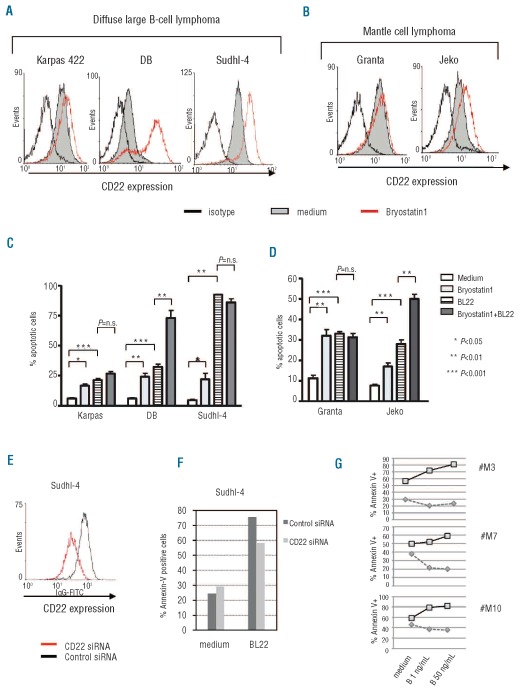Figure 4.
Bryostatin 1 and BL22 exert anti-lymphoma effects in DLBCL and mantle cell lymphoma cells. (A) Diffuse large B-cell lymphoma cell lines or mantle cell lymphoma cell lines (B) were exposed to bryostatin 1 (1 ng/mL) (red line). After 48 h the expression of CD22 was determined by flow cytometry and compared to untreated cells (shaded histograms). (C) DLBCL cells or (D) mantle cell lymphoma cell lines were treated with bryostatin 1 (1 ng/mL) or BL22 (100 ng/mL) or a combination of both drugs. After 48 h the amount of apoptotic cells was analyzed by Annexin-V/PI staining. Experiments were carried out in triplicates. (E) Sudhl-4 cells were either transfected two times with an siRNA against CD22 or a control siRNA. CD22 surface expression was reduced as determined by flow cytometry analysis. (F) CD22-modified cells were exposed for an additional 24 h to BL22 (100 ng/mL) before cell death was analyzed by Annexin-V staining. One representative experiment out of 4 is shown. (G) Primary mantle cell leukemic cells from 3 different patients (#M3,7,10) were treated with bryostatin 1(B) at a concentration of 1 and 50 ng/mL for 48 h. Single agent treatment reduced spontaneous apoptosis of primary MCL cells (⋄). In contrast, the cytotoxicity of BL22 (1000 ng/mL) was enhanced in the presence of bryostatin 1 (□).

